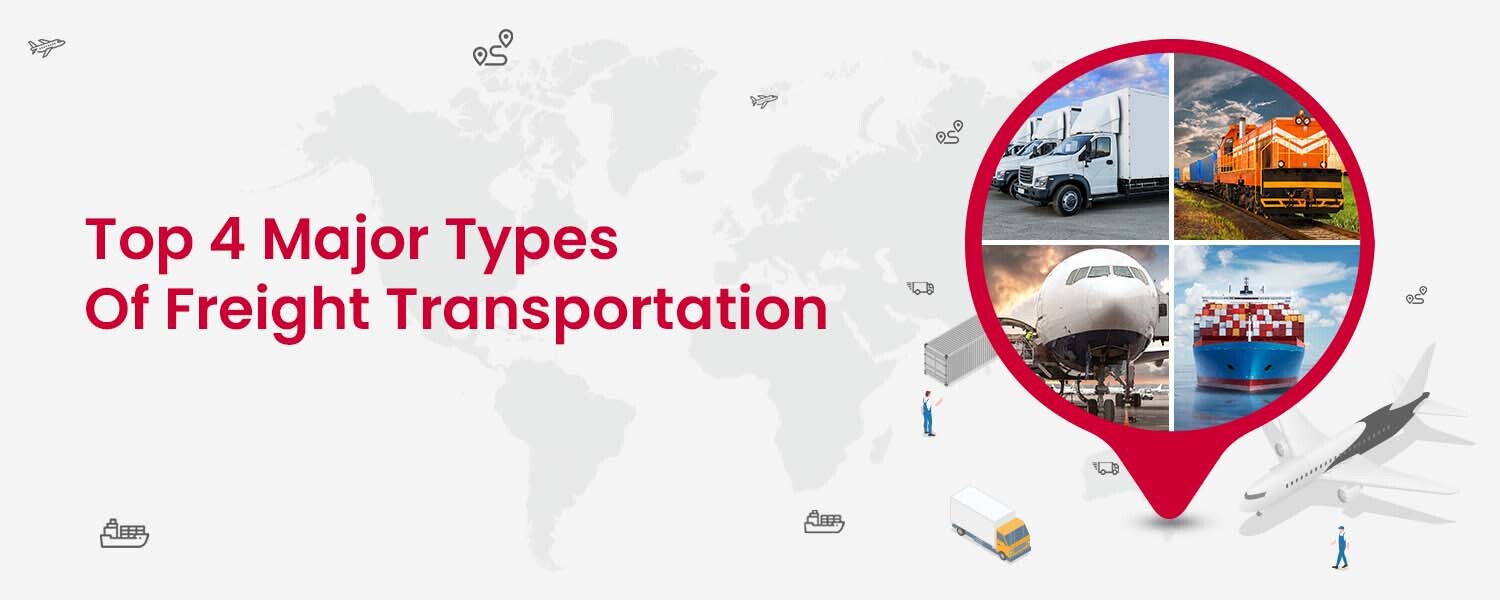The world is constantly changing and innovating to address the problems we’re facing– whether big or small. In the past, we used to be highly dependent on physical stores to buy, but then eCommerce was born, and we started shopping online from the comfort of our homes. Now people can buy products from anywhere. The movement of goods from one location to another is vital for the functioning of modern economies. Freight transportation plays a crucial role in this process, allowing businesses to transport their goods to consumers promptly and efficiently.
If you read this blog, you’ll learn what freight transportation is and what types of freight transportation exist.
What Is Freight Transportation?
Freight transportation is the backbone of modern economies. It’s the process of moving goods and products from one location to another. This process encompasses various stages, such as logistics, conveyance, and the resources used to reach the final destination.
Current trends show that the road remains the primary means of transportation for eCommerce, as it’s efficient and reliable. However, more complex supply chain solutions have been developed as customers demand faster delivery times. An example is drop trailers, also known as stand-by trailers, where the full trailers are picked up by drivers who arrive with empty trailers and then pick up the already-loaded trailers. This allows the shipper and the carrier to utilize their assets more efficiently and ensures that goods move between warehouses, distribution centres, and arrival locations on time.
An example of freight transport would be a shipping company transporting a container of manufactured goods, such as electronics or clothing, from a factory in China to a port in the United States. The container would be loaded onto a cargo ship and then transported by sea to the US port. From there, it would be offloaded and transported via truck or rail to a distribution centre or warehouse, where it would be sorted and prepared for delivery to retailers or customers. This type of freight transport involves multiple stages, including logistics, conveyance, and distribution, and it typically utilizes a combination of different modes of transportation, such as sea, road, and rail.
Types of Freight Transportation
Road Freight Transportation
Road freight transportation refers to moving goods via truck or other road vehicles. This type of transportation is used to transport various goods, including raw materials, finished products, and even hazardous materials. Road freight transportation allows for door-to-door delivery, which can benefit time-sensitive or perishable goods. However, there are also some downsides to road freight transportation. One major disadvantage is that it can be affected by traffic congestion and road closures, which can cause delays.
Road freight transportation is often used in the Indian eCommerce industry to transport goods from warehouses to customers. According to the Ministry of Road Transport and Highways, The Road Transport Sector accounts for about 87% of passenger traffic and 60% of freight traffic movement in the country. In addition, road transport also acts as a feeder service to the railway, shipping, and air traffic.
Rail Freight Transportation
This mode of transportation is often used for large shipments of goods that need to be transported over long distances, such as raw materials, coal, and manufactured products.
One of the biggest advantages of rail freight transportation is its efficiency. Trains can carry large amounts of cargo at one time and quickly cover long distances. This makes rail freight transportation a cost-effective option for shipping heavy and bulky goods.
Air Freight Transportation
Air freight transportation, also known as air cargo, is the movement of goods via aeroplanes. This mode of transportation is often used for time-sensitive or high-value goods that need to be transported quickly and efficiently, such as electronics, medical equipment, and perishables.
Aeroplanes can cover long distances in a relatively short amount of time, which makes them a great option for time-sensitive shipments. Additionally, air freight transportation is not affected by traffic congestion or road closures, which can cause delays for ground transportation.
Water Freight Transportation
Water freight transportation is the movement of goods via ships and other vessels on oceans, rivers, and other bodies of water. This mode of transportation is often used for large shipments of goods that need to be transported over long distances. Ships can carry large amounts of cargo at one time and can cover long distances relatively cheaply, making them a great option for heavy and bulky goods. On the other hand, water freight transportation has some limitations as well. It requires a significant infrastructure investment, including ports and terminals, which can be costly.
Difference Between Freight And Transport
Cost
When it comes to the cost of moving goods, freight costs are the charges that cover the cost of the goods themselves, including things like packaging and handling. These costs can vary depending on the type and quantity of goods being shipped and the distance they are travelling. On the other hand, transport costs are the charges associated with the physical movement of goods. This can include things like fuel, labour, and equipment costs. Again, these costs can vary depending on the transport mode.
Nature Of The Goods
Different types of goods require different modes of transportation based on their nature and characteristics. For example, perishable goods such as fruits, vegetables, and dairy products must be transported quickly and efficiently to maintain their freshness and quality. Air transport is the best option in this case as it can cover long distances in a relatively short amount of time. Plus, it’s not affected by traffic congestion or road closures which can cause delays in ground transportation. In contrast, heavy machinery and other bulky equipment require a different type of transport altogether. Water transport is the best option here as ships can carry large amounts of cargo at one time and can conveniently cover long distances.
Responsibility
The shipper is responsible for the freight and its contents. They are the ones who package and prepare the goods for transport and are responsible for ensuring that the goods are properly labelled and described. On the other hand, the carrier is responsible for transporting the freight. They are responsible for providing the means of transportation, such as a truck, train, or ship, as well as the personnel to operate it.
Insurance
There’s always a risk of something going wrong, and that’s where insurance comes in. But, just like with responsibilities, the shipper’s and carrier’s insurance needs are different. Freight can be insured to protect against loss or damage while in transit. However, it’s important to note that not all freight is automatically insured, and shippers may need to purchase separate insurance coverage.
On the other hand, transport may or may not be insured depending on the agreement between the shipper and carrier. Some carriers may include insurance coverage as part of their service, while others may require the shipper to purchase separate insurance coverage.
It’s important to note that not all insurance policies are created equal, and shippers and carriers need to review the terms and conditions of any insurance policy carefully.
Logistics
Logistics is like a big jigsaw puzzle, with many pieces that need to fit together to complete the picture. And one of those pieces is freight, while another is transported. Freight is the physical goods being moved, and it’s a crucial part of logistics and supply chain management.
On the other hand, transport is the method used to move freight from one place to another. It’s a sub-part of logistics and supply chain management that deals with the movement of goods. Logistics professionals need to plan, manage, and optimize freight transport.
What Is The Role Of Freight Transport
Movement Of Goods
When it comes to moving goods, freight transport plays a crucial role in the planning, management, and optimization of the movement of goods. It helps eCommerce sellers to determine the most efficient and cost-effective routes and modes of transport. This includes carrier selection, route planning, and compliance with regulations. It also helps find the right balance between speed, cost, and reliability.
Carrier Selection And Route Planning
Choosing the right carrier can mean a successful delivery and a missed deadline. The carrier and the route are just as important as the goods themselves. And that’s where freight transport plays a key role in carrier selection and route planning. Freight transport helps logistics professionals find the right carrier for the job, including evaluating carrier performance, determining carrier capabilities, and comparing carrier rates. Logistics professionals must consider many factors when selecting a carrier, such as costs, reliability, and transit times.
Freight transport also helps find the most efficient and cost-effective routes by evaluating traffic patterns, determining the best mode of transport, and factoring in transit times and distances. Logistics professionals must consider many factors when planning a route, such as costs, distance, and time.
Compliance With Laws And Regulations
There are a lot of rules and regulations to follow. Freight transport helps ensure compliance with laws and regulations by ensuring that all the necessary documentation is in order. This includes bills of lading, customs declarations, and safety compliance documentation. eCommerce sellers must ensure that all documentation is accurate and complete to avoid delays or penalties while transporting freight.
Improving Customer Service
When it comes to moving goods, customer service is king, and freight transportation helps in improving customer service by reducing lead times. Logistics professionals can ensure that goods are delivered as quickly as possible by choosing the right carrier, route, and mode of transport. This can help businesses to meet customer demand and ensure customer satisfaction.
It also helps in improving delivery frequency. Online retailers can ensure that goods are delivered more frequently by optimizing routes and scheduling regular deliveries. This can help businesses to meet customer demand and ensure customer satisfaction. In addition, by using technology such as GPS tracking and delivery notifications, you can provide customers with real-time information about the status of their deliveries. This can help customers to plan their operations and ensure customer satisfaction.
Conclusion
The world of freight transportation is a vast and varied landscape, but these major types of freight transportation are sure to get your goods from point A to point B in no time. As a new online seller, whether you’re shipping by truck, train, ship, or plane, you can rest easy knowing that your cargo is in good hands. But easy shipping and timely freight movement correlate with the efficiency of a carrier or shipping (FedEx, Blue Dart, DHL, etc.). You must choose an experienced and well-equipped courier company to ensure your cargo is in good hands. Do your own research or consult with NimbusPost– one of the leading logistics aggregators, where you can analyze the metrics and KPIs of some of the best courier companies in the country and choose one for you. So, next time you have something to ship, don’t be afraid to think outside the box (truck) and explore your options. Happy hauling!
FAQs
Are Freight And Trucking The Same?
Freight and trucking are related but not the same.
Freight refers to the goods or cargo that is being transported. It can be anything, from raw materials and manufactured goods to livestock. It can be transported by various means, including by truck, train, ship, or aeroplane. On the other hand, trucking specifically refers to transporting goods by truck. It is a mode of freight transportation. Trucks are one of the most common and cost-effective means of transportation for short and medium-distance transportation.
How do you classify freight?
Freight can be classified based on several factors, such as the type of goods, their weight, volume, and mode of transportation.
What is freight in logistics?
In logistics, freight refers to the physical goods being transported from one place to another. It can include raw materials, finished products, or anything else that needs to be moved.
What is FOB and freight terms?
FOB stands for “Free on Board” and refers to a shipping agreement where the seller is responsible for the goods until they are loaded onto a carrier. Freight terms, on the other hand, specify the responsibilities of both the buyer and seller regarding the shipment.
What are the two types of freight cost?
The two types of freight costs are inbound and outbound. Inbound costs are associated with receiving goods from suppliers, while outbound costs are related to shipping products to customers.
What is the difference between freight and logistics?
Freight refers to the actual goods being transported, while logistics encompasses the entire process of getting those goods from one place to another, including planning, coordination, and management.
What is CIF and FOB?
CIF stands for “Cost, Insurance, and Freight” and is a shipping agreement where the seller is responsible for the cost of goods, insurance, and freight until they reach the destination port. FOB, on the other hand, only covers the cost of goods until they are loaded onto a carrier.




